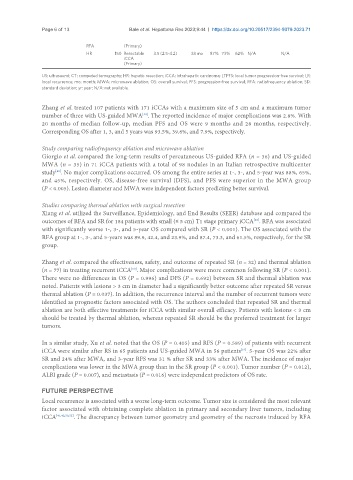Page 141 - Read Online
P. 141
Page 6 of 13 Bale et al. Hepatoma Res 2023;9:44 https://dx.doi.org/10.20517/2394-5079.2023.71
RFA (Primary)
HR 150 Resectable 3.5 (2.5-4.2) 38 mo 87% 73% 62% N/A N/A
iCCA
(Primary)
US: ultrasound; CT: computed tomography; HR: hepatic resection; iCCA: intrahepatic carcinoma; LTPFS: local tumor progression-free survival; LR:
local recurrence; mo: month; MWA: microwave ablation; OS: overall survival; PFS: progression-free survival; RFA: radiofrequency ablation; SD:
standard deviation; yr: year; N/A: not available.
Zhang et al. treated 107 patients with 171 iCCAs with a maximum size of 5 cm and a maximum tumor
[48]
number of three with US-guided MWA . The reported incidence of major complications was 2.8%. With
20 months of median follow-up, median PFS and OS were 9 months and 28 months, respectively.
Corresponding OS after 1, 3, and 5 years was 93.5%, 39.6%, and 7.9%, respectively.
Study comparing radiofrequency ablation and microwave ablation
Giorgio et al. compared the long-term results of percutaneous US-guided RFA (n = 36) and US-guided
MWA (n = 35) in 71 iCCA patients with a total of 98 nodules in an Italian retrospective multicenter
study . No major complications occurred. OS among the entire series at 1-, 3-, and 5-year was 88%, 65%,
[49]
and 45%, respectively. OS, disease-free survival (DFS), and PFS were superior in the MWA group
(P < 0.005). Lesion diameter and MWA were independent factors predicting better survival.
Studies comparing thermal ablation with surgical resection
Xiang et al. utilized the Surveillance, Epidemiology, and End Results (SEER) database and compared the
[29]
outcomes of RFA and SR for 184 patients with small (≤ 5 cm) T1 stage primary iCCA . RFA was associated
with significantly worse 1-, 3-, and 5-year OS compared with SR (P < 0.001). The OS associated with the
RFA group at 1-, 3-, and 5-years was 89.9, 42.4, and 23.9%, and 87.4, 73.3, and 61.5%, respectively, for the SR
group.
Zhang et al. compared the effectiveness, safety, and outcome of repeated SR (n = 32) and thermal ablation
(n = 77) in treating recurrent iCCA . Major complications were more common following SR (P < 0.001).
[50]
There were no differences in OS (P = 0.996) and DFS (P = 0.692) between SR and thermal ablation was
noted. Patients with lesions > 3 cm in diameter had a significantly better outcome after repeated SR versus
thermal ablation (P = 0.037). In addition, the recurrence interval and the number of recurrent tumors were
identified as prognostic factors associated with OS. The authors concluded that repeated SR and thermal
ablation are both effective treatments for iCCA with similar overall efficacy. Patients with lesions < 3 cm
should be treated by thermal ablation, whereas repeated SR should be the preferred treatment for larger
tumors.
In a similar study, Xu et al. noted that the OS (P = 0.405) and RFS (P = 0.589) of patients with recurrent
[51]
iCCA were similar after RS in 65 patients and US-guided MWA in 56 patients . 5-year OS was 22% after
SR and 24% after MWA, and 3-year RFS was 31 % after SR and 33% after MWA. The incidence of major
complications was lower in the MWA group than in the SR group (P < 0.001). Tumor number (P = 0.012),
ALBI grade (P = 0.007), and metastasis (P = 0.016) were independent predictors of OS rate.
FUTURE PERSPECTIVE
Local recurrence is associated with a worse long-term outcome. Tumor size is considered the most relevant
factor associated with obtaining complete ablation in primary and secondary liver tumors, including
iCCA [41,42,50,52] . The discrepancy between tumor geometry and geometry of the necrosis induced by RFA

